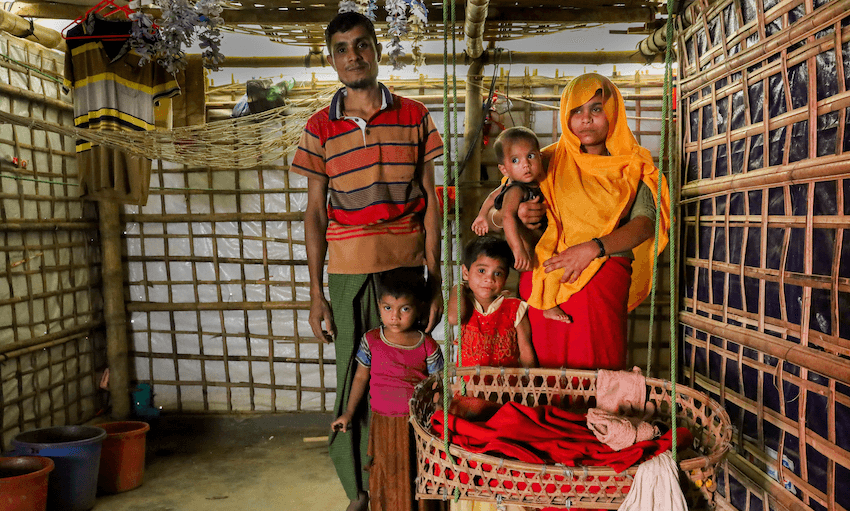One million people from Myanmar live in 34 camps in Cox’s Bazar, Bangladesh. They are considered some of the largest and most densely populated camps in the world. New Zealand Red Cross’ international delegate Elodie Berthe shares some of their stories.
After what seemed like an never-ending car journey on windy roads full of potholes, roadworks and a chaos of cars and trucks, we finally arrived in the camps of Cox’s Bazar. The 34 camps hosting one million people who fled violence in Rakhine state, Myanmar, are located only 44km south of the touristy town of Cox’s Bazar, but the slowness of the ride feels like you have travelled at least twice that far.
The atmosphere of the camps in Cox’s Bazar may feel like a vibrant Bangladeshi city at first. Tom-toms (a type of auto rickshaw) storm down the road, avoiding at the very last moment people carrying metres-long bamboo poles on their shoulders and kids running after chickens, while the smell of freshly made bread attracts shoppers, fisherman sell their catch of the day, teenagers play cane ball and even barbers ensure customers’ beards look sharp.
But the first impression of the camps is misleading. It is only once you’ve ventured among the narrow alleyways and got lost among tightly packed shelters surrounded by piles of rubbish, or after you’ve reached a hilltop with a 360-degree view over thousands of tiny homes built on unstable land, that the reality becomes clear.
Since 25 August 2017, more than 700,000 people have arrived in Bangladesh, fleeing violence in Myanmar’s Rakhine state and triggering one of the region’s largest and most complex protracted humanitarian crises in decades. Today, more than one million people are living in an extremely precarious situation and continue to face instability, health issues, poverty, natural and climatic hazards, and congested living conditions.
The camps have a population density of over 60,000 people per square kilometre – one and a half times that of Manila, the most densely populated city on earth. The humanitarian standard for population density is 30m² per person. The average space per person in Cox’s Bazar is 24m², falling to just 10m² in the most densely crowded areas. Most families have far less than this.
Though living conditions are heartbreaking, it’s the people themselves who make this place so vibrant and so welcoming. Behind the striking statistics are people with the incredible strength to persevere despite their difficult conditions and the trauma they have gone through on their journey to Bangladesh. They’re people with stories to tell about their daily challenges, their hopes and dreams for their future, their hobbies, their family history, or innovative ways they have found to make life a little easier.
People like Sadyra, a natural woodworker and handyman. When we met in front of his shelter, he explained that he wants to build a bigger house for his family. He made the chair he is sitting on.
Or Sakina, who told me that it took seven days to reach Bangladesh with eight members of her family, including her husband who has a disability due to being a victim of violence. Life is difficult, she said, but she’s happy to have learnt how to make fishing nets at the community centre run by the Bangladesh Red Crescent Society (the Bangladeshi version of the Red Cross).
“I’ve learnt a lot at the centre, including how to live with dignity. It’s also better to spend time here than sitting at home where there are so many problems. The centre provides me with a relief from my worries,” Sakina told me.
These people also include Red Crescent volunteers like Azar and Muhammed, who are displaced from Myanmar themselves but working to support their community through the WASH (Water, Sanitation and Hygiene) programme. They were eager to show me the set up that provides clean water throughout the camps.
“After we drink, we don’t get diseases and we are getting better, better than better,” says Azar, about the access to clean water for him and his community.
Or Alma, who burst out laughing when I asked if she could show me her new water point. She used to walk 30 minutes across the camps to fetch dirty water which made her and her family sick. Now she can simply use the taps built right beside her doorstep.
Moahmmed proudly showed me his home which he built after attending Red Crescent’s PASSA (Participation Approach for Safe Shelter Awareness) training, aimed at ensuring people living in the camps are equipped with the right knowledge to build their own shelter for the conditions of the camps.
“I’m very happy with my home. It’s safe and we no longer have rats, dogs and cats coming into our house now because our floor is strong enough that they can’t enter. It also doesn’t get too hot, because I learnt how to have some air passing system,” explained Mohammed.
I met another Mohammed while he was.visiting the medical centre. It was his twelfth visit of the year to the clinic; he has a chronic disease. Just like all people in the camps, he is able to see a health professional and get medication at no cost.
“I don’t know what I would do without this health post – I would struggle and not be treated. Who knows what would happen to me?” he said.
Long after I return home to New Zealand, I’ll think of Salma, Dilda, Abdul, Shifika, Hafaz, Rohima and many more who welcomed me into their home and shared their stories of courage, determination and hope. People who, along with another million more, deserve not to be forgotten by those of us lucky enough not to live in places like Cox’s Bazar.
Elodie Berthe is a New Zealand Red Cross communications delegate.
